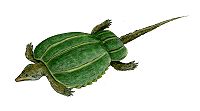
Psephoderma
Encyclopedia
Psephoderma is a genus of placodont
that was very similar to its relatives Placochelys
and Cyamodus
. Psephoderma had a flattened skull
and a narrow, straight rostrum
. Inside this skull
, embedded in the jaws, were rounded teeth specialized for crushing the shellfish
it ate. Unlike most placodont
s, Psephoderma had a carapace
that was divided into two pieces, one on the shoulders and back, another on the rear end. Psephoderma grew to 180 cm long and lived in the Late Triassic
(Norian
), about 210 million years ago. It was one of the last placodont
s to live.

Placodont
Placodonts were a group of marine reptiles that lived during the Triassic period, becoming extinct at the end of the period. It is believed that they were part of Sauropterygia, the group that includes Plesiosaurs...
that was very similar to its relatives Placochelys
Placochelys
Placochelys is an extinct genus of reptile from the Triassic period of Germany.Placochelys looked remarkably similar to a sea turtle, and grew to about in length. It had a flat shell covered with knobbly plates, and a compact skull...
and Cyamodus
Cyamodus
Cyamodus was a placodont, known from fossil remains discovered in Germany, in the early-to-mid-19th century and was named by Christian Erich Hermann von Meyer, in 1863. The fossils have been dated to the Triassic Period, from the Anisian to Ladinian stages...
. Psephoderma had a flattened skull
Skull
The skull is a bony structure in the head of many animals that supports the structures of the face and forms a cavity for the brain.The skull is composed of two parts: the cranium and the mandible. A skull without a mandible is only a cranium. Animals that have skulls are called craniates...
and a narrow, straight rostrum
Rostrum (anatomy)
The term rostrum is used for a number of unrelated structures in different groups of animals:*In crustaceans, the rostrum is the forward extension of the carapace in front of the eyes....
. Inside this skull
Skull
The skull is a bony structure in the head of many animals that supports the structures of the face and forms a cavity for the brain.The skull is composed of two parts: the cranium and the mandible. A skull without a mandible is only a cranium. Animals that have skulls are called craniates...
, embedded in the jaws, were rounded teeth specialized for crushing the shellfish
Shellfish
Shellfish is a culinary and fisheries term for exoskeleton-bearing aquatic invertebrates used as food, including various species of molluscs, crustaceans, and echinoderms. Although most kinds of shellfish are harvested from saltwater environments, some kinds are found only in freshwater...
it ate. Unlike most placodont
Placodont
Placodonts were a group of marine reptiles that lived during the Triassic period, becoming extinct at the end of the period. It is believed that they were part of Sauropterygia, the group that includes Plesiosaurs...
s, Psephoderma had a carapace
Carapace
A carapace is a dorsal section of the exoskeleton or shell in a number of animal groups, including arthropods such as crustaceans and arachnids, as well as vertebrates such as turtles and tortoises. In turtles and tortoises, the underside is called the plastron.-Crustaceans:In crustaceans, the...
that was divided into two pieces, one on the shoulders and back, another on the rear end. Psephoderma grew to 180 cm long and lived in the Late Triassic
Triassic
The Triassic is a geologic period and system that extends from about 250 to 200 Mya . As the first period of the Mesozoic Era, the Triassic follows the Permian and is followed by the Jurassic. Both the start and end of the Triassic are marked by major extinction events...
(Norian
Norian
The Norian is a division of the Triassic geological period. It has the rank of an age or stage . The Norian lasted from 216.5 ± 2.0 to 203.6 ± 1.5 million years ago. It was preceded by the Carnian and succeeded by the Rhaetian.-Stratigraphic definitions:The Norian was named after the Noric Alps in...
), about 210 million years ago. It was one of the last placodont
Placodont
Placodonts were a group of marine reptiles that lived during the Triassic period, becoming extinct at the end of the period. It is believed that they were part of Sauropterygia, the group that includes Plesiosaurs...
s to live.


